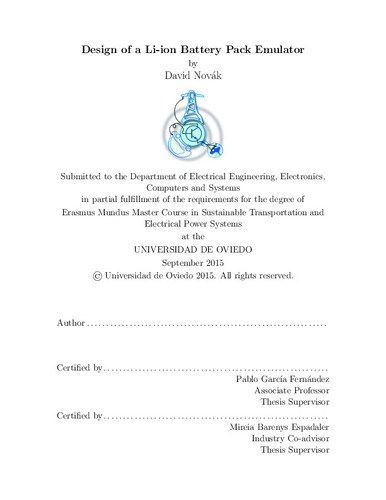Design of a Li-ion battery pack emulator
Autor(es) y otros:
Director(es):
Palabra(s) clave:
Li-ion battery
Battery emulator
DSP
Curve fitting model
Shepherd model
IQMath library
Embedded coder
Temperature effect
C-rate effect
Fecha de publicación:
Serie:
Máster Universitario Erasmus Mundus en Transporte Sostenible y Sistemas Eléctricos de Potencia (EMMC STEPS)
Resumen:
Due to the continuously increasing portion of renewable energy sources that are being connected to the grid, grid energy storage systems are now calling for attention more than ever before, to improve the grid's power quality and stability. For this purpose, Li-ion Batteries (LIBs) are currently considered as the most promising technology, because of its relative maturity and premise that the cost for LIBs shall decrease significantly in the forthcoming years. Hence, recognizing the potential of LIBs and their still relatively high cost, this study aims to develop a Li-ion Battery Emulator (BE). This BE shall therefore substitute a real LIB in any desired power system, microgrid or smartgrid laboratory setup, allowing to proceed further in both research and industry related applications. In this work, firstly the motivation for the choice of LIBs is presented, following with background of the Li-ion technology and a thorough description of LIB characteristics. Next, a literature review of the state of the art of LIB models is provided. Based on the literature review, three data sheet based LIB models are developed in Matlab-Simulink and compared (i.e. Shepherd's original model, Shepherd's modified model and Curve fitting model). The most suitable model: the Curve fitting model, is further optimized for direct C-code generation through Embedded-Coder platform in Matlab-Simulink, upon which the generated C-code is successfully implemented inside a fixed-point Digital Signal Processor (DSP)
Due to the continuously increasing portion of renewable energy sources that are being connected to the grid, grid energy storage systems are now calling for attention more than ever before, to improve the grid's power quality and stability. For this purpose, Li-ion Batteries (LIBs) are currently considered as the most promising technology, because of its relative maturity and premise that the cost for LIBs shall decrease significantly in the forthcoming years. Hence, recognizing the potential of LIBs and their still relatively high cost, this study aims to develop a Li-ion Battery Emulator (BE). This BE shall therefore substitute a real LIB in any desired power system, microgrid or smartgrid laboratory setup, allowing to proceed further in both research and industry related applications. In this work, firstly the motivation for the choice of LIBs is presented, following with background of the Li-ion technology and a thorough description of LIB characteristics. Next, a literature review of the state of the art of LIB models is provided. Based on the literature review, three data sheet based LIB models are developed in Matlab-Simulink and compared (i.e. Shepherd's original model, Shepherd's modified model and Curve fitting model). The most suitable model: the Curve fitting model, is further optimized for direct C-code generation through Embedded-Coder platform in Matlab-Simulink, upon which the generated C-code is successfully implemented inside a fixed-point Digital Signal Processor (DSP)
Colecciones
- Trabajos Fin de Máster [5284]
Ficheros en el ítem





